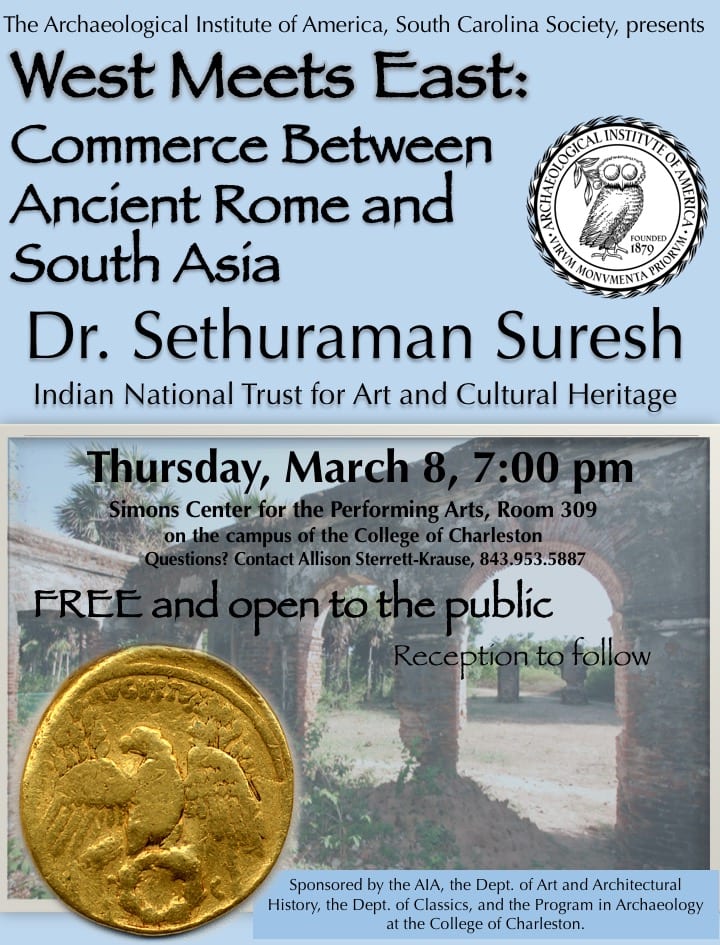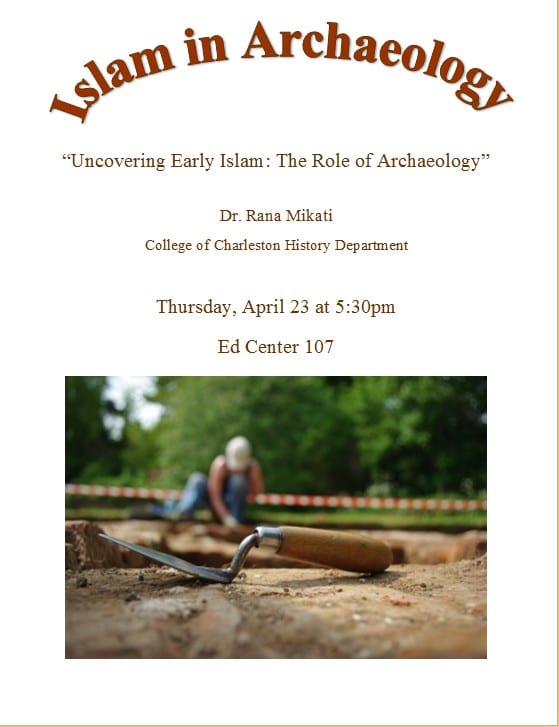 Please join the Archaeological Institute of America for our next free public lecture by Dr. Sethuraman Suresh: “West Meets East: Commerce between Ancient Rome and South Asia.” The lecture will take place on Thursday, March 8 at 7:00 pm, with questions and a reception to follow. This AIA lecture (co-sponsored by the Departments of Art and Architectural History and Classics and the Program in Archaeology) will be held in Simons 309, the large lecture room. More details here: https://aiasouthcarolina.wordpress.com/2018/02/06/upcoming-lecture-west-meets-east-3-8-18/
Please join the Archaeological Institute of America for our next free public lecture by Dr. Sethuraman Suresh: “West Meets East: Commerce between Ancient Rome and South Asia.” The lecture will take place on Thursday, March 8 at 7:00 pm, with questions and a reception to follow. This AIA lecture (co-sponsored by the Departments of Art and Architectural History and Classics and the Program in Archaeology) will be held in Simons 309, the large lecture room. More details here: https://aiasouthcarolina.wordpress.com/2018/02/06/upcoming-lecture-west-meets-east-3-8-18/
Tag Archives: archaeology
Allison Sterrett-Krause Publishes on Roman Glass

Source: The College Today. College of Charleston
Dr. Allison Sterrett-Krause’s latest article in the Journal of Glass Studies is now out:
Sterrett-Krause, A. 2017. ‘Drinking with the Dead? Glass from Roman and Christian Burial Areas at Leptiminus (Lamta, Tunisia).’ Journal of Glass Studies 59: 47-82.
Check out the recent article on Dr. Sterrett-Krause’s work in The College Today.
Study Abroad in Greece 2018 Heads to Islands, Actium
 From May 17 to June 15, Drs. Alwine and Flores will lead students on a study of the sites and scenes of ancient Greek civilization. Their travels will take them to expected places essential for any first-time experience (Delphi, Olympia, Athens, Mycenae), but will also include time in the northwestern section of the country around Preveza/Actium.
From May 17 to June 15, Drs. Alwine and Flores will lead students on a study of the sites and scenes of ancient Greek civilization. Their travels will take them to expected places essential for any first-time experience (Delphi, Olympia, Athens, Mycenae), but will also include time in the northwestern section of the country around Preveza/Actium.
Interested students are encouraged to contact Dr. Alwine or Dr. Flores, and to visit the ‘CofC Greece 2018‘ Facebook page.
James Newhard on Chipped Stone
Congratulations to Professor Jim Newhard. His book chapter “A survey of chipped stone resources and production in the Argolid” has been published in Lithics Past and Present: Perspectives on Chipped Stone Studies in Greece (Studies in Mediterranean Archaeology 144) 141-158.
“This study investigates the acquisition, production and distribution patterns of chert in the Bronze Age Argolid. Specific focus is placed on the identification of lithic resources which would have provided usable cherts to Argive settlements … The movement of chert from resource acquisition to final location of manufacture and deposition highlights patterns of subsistence, transport and economy that often operate outside the purview of societal elites.”
Dr. Allison Sterrett-Krause Publishes on “Drinking with the Dead”
Congratulations to Dr. S.-K. whose article, “Drinking with the Dead? Glass from Roman and Christian Burial Areas at Leptiminus (Lamta, Tunisia),” has been accepted for publication in the Journal of Glass Studies.
Summary: Excavations by the Leptiminus Archaeological Project at the East Cemetery in Leptiminus (Lamta, Tunisia) revealed a substantial quantity of late Roman and Byzantine glass fragments. Some of these vessel fragments, found in tombs, may represent grave gifts or symbolize elements of funerary ritual. Most of the vessels, found in nonburial contexts that formed during the cemetery’s periods of use (late second–late sixth centuries), suggest that glass vessels probably played an important role in commemorative activities at the cemetery. The presence of possible glass drinking sets in an area used for Christian burials suggests that rituals involving drinking or pouring libations may have regularly taken place nearby. These rituals probably followed longstanding traditions associated with commemorating the deceased in Roman society, highlighting the role of glass vessels in creating continuities between Roman and Christian practice.
Archaeologists Report on Summer Research
On Thursday, September 8, the Archaeology Program co-sponsored the opening talk in the South Carolina Society of the Archaeological Institute of America’s 2016-17 lecture series. The evening featured short reports from CofC faculty engaged in research. Dr. Maureen Hays reported on her excavations (involving CofC students) at the original site of St. Paul’s Parish Church and parsonage. Dr. Scott Harris reported on his work in uncovering the submerged landscapes of Greece, undertaken as a Fulbright fellow. Dr. Allison Sterrett-Krause reported on her ongoing work on the funerary practices of late Roman north Africa and daily life in a ‘working man’s’ section of Pompeii via the study glass artifacts in collaboration with CofC students. Dr. Alvaro Ibarra reported on ongoing excavations at the Roman military outpost of Castra Cumidava (modern-day Romania), and Dr. James Newhard spoke of research conducted to date that is leading him to further investigations of the ancient city of Epidaurus (Greece).
For further information on these investigations, please contact the respective principal investigators.

